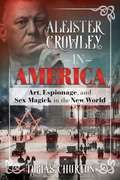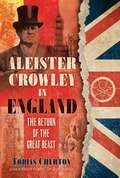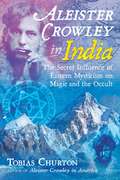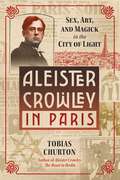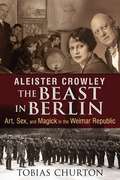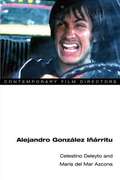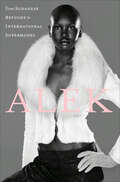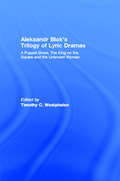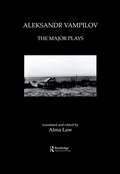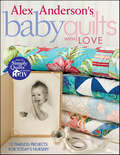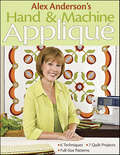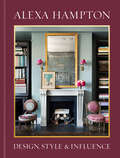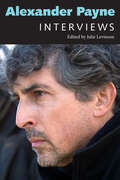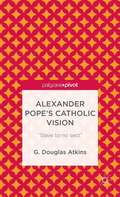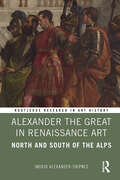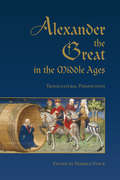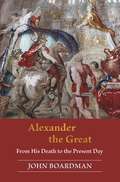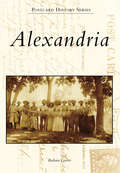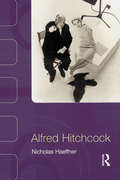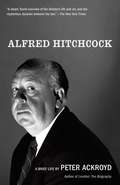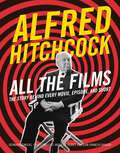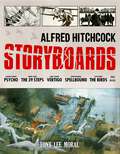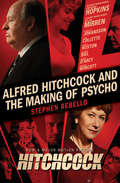- Table View
- List View
Aleister Crowley in America: Art, Espionage, and Sex Magick in the New World
by Tobias ChurtonAn exploration of Crowley’s relationship with the United States • Details Crowley’s travels, passions, literary and artistic endeavors, sex magick, and psychedelic experimentation • Investigates Crowley’s undercover intelligence adventures that actively promoted U.S. involvement in WWI • Includes an abundance of previously unpublished letters and diaries Occultist, magician, poet, painter, and writer Aleister Crowley’s three sojourns in America sealed both his notoriety and his lasting influence. Using previously unpublished diaries and letters, Tobias Churton traces Crowley’s extensive travels through America and his quest to implant a new magical and spiritual consciousness in the United States, while working to undermine Germany’s propaganda campaign to keep the United States out of World War I. Masterfully recreating turn-of-the-century America in all its startling strangeness, Churton explains how Crowley arrived in New York amid dramatic circumstances in 1900. After other travels, in 1914 Crowley returned to the U.S. and stayed for five years: turbulent years that changed him, the world, and the face of occultism forever. Diving deeply into Crowley’s 5-year stay, we meet artists, writers, spies, and government agents as we uncover Crowley’s complex work for British and U.S. intelligence agencies. Exploring Crowley’s involvement with the birth of the Greenwich Village radical art scene, we discover his relations with writers Sinclair Lewis and Theodore Dreiser and artists John Butler Yeats, Leon Engers Kennedy, and Robert Winthrop Chanler while living and lecturing on now-vanished “Genius Row.” We experience his love affairs and share Crowley’s hard times in New Orleans and his return to health, magical dynamism, and the most colorful sex life in America. We examine his controversial political stunts, his role in the sinking of the passenger ship Lusitania, his making of the “Elixir of Life” in 1915, his psychedelic experimentation, his prolific literary achievements, and his run-in with Detroit Freemasonry. We also witness Crowley’s influence on Scientology founder L. Ron Hubbard and rocket fuel genius Jack Parsons. We learn why J. Edgar Hoover wouldn’t let Crowley back in the country and why the FBI raided Crowley’s organization in LA. Offering a 20th-century history of the occult movement in the United States, Churton shows how Crowley’s U.S. visits laid the groundwork for the establishment of his syncretic “religion” of Thelema and the now flourishing OTO, as well as how Crowley’s final wish was to have his ashes scattered in the Hamptons.
Aleister Crowley in England: The Return of the Great Beast
by Tobias Churton• Reveals Crowley&’s sex magick relations in London and his contacts with important figures, including Dion Fortune, Gerald Gardner, Jack Parsons, Dylan Thomas, and black equality activist Nancy Cunard • Explores Crowley&’s nick-of-time escape from the Nazi takeover in Germany and offers extensive confirmation of Crowley&’s work for British intelligence • Examines the development of Crowley&’s later publications and his articles in reaction to the Nazi Gestapo actively persecuting his followers in Germany After an extraordinary life of magical workings, occult fame, and artistic pursuits around the globe, Aleister Crowley was forced to spend the last fifteen years of his life in his native England, nearly penniless. Much less examined than his early years, this final period of the Beast&’s life was just as filled with sex magick, espionage, romance, transatlantic conflict, and extreme behavior. Drawing on previously unpublished diaries and letters, Tobias Churton provides the first detailed treatment of the final years of Crowley&’s life, from 1932 to 1947. He opens with Crowley&’s nick-of-time escape from the Nazi takeover in Germany and his return home to England, flat broke. Churton offers extensive confirmation of Crowley&’s work as a secret operative for MI5 and explores how Crowley saw World War II as the turning point for the &“New Aeon.&” He examines Crowley&’s notorious 1934 London trial, which resulted in his bankruptcy, and shares inside stories of Crowley&’s relations with Californian O.T.O. followers, including rocket-fuel specialist Jack Parsons, and his attempt to take over H. Spencer Lewis&’s Rosicrucian Order. The author reveals Crowley&’s sex magick relations in London and his contacts with spiritual leaders of the time, including Dion Fortune and Wicca founder Gerald Gardner. He examines Crowley&’s dealings with artists such as Dylan Thomas, Alfred Hitchcock, Augustus John, Peter Warlock, and Peter Brooks and dispels the accusations that Crowley was racist, exploring his work with lifelong friend, black equality activist Nancy Cunard. Churton also examines the development of Crowley&’s later publications such as Magick without Tears as well as his articles in reaction to the Nazi Gestapo who was actively persecuting his remaining followers in Germany. Presenting an intimate and compelling study of Crowley in middle and old age, Churton shows how the Beast still wields a wand-like power to delight and astonish.
Aleister Crowley in India: The Secret Influence of Eastern Mysticism on Magic and the Occult
by Tobias ChurtonFollow Aleister Crowley through his mystical travels in India, which profoundly influenced his magical system as well as the larger occult world • Shares excerpts from Crowley&’s unpublished diaries and details his travels in India, Burma, and Sri Lanka from 1901 to 1906 • Reveals how Crowley incorporated what he learned in India--jnana yoga, Vedantist, Tantric, and Buddhist philosophy--into his own school of Magick • Explores the world of Theosophy, yogis, Hindu traditions, and the first Buddhist sangha to the West as well as the first pioneering expeditions to K2 and Kangchenjunga in 1901 and 1905 Early in life, Aleister Crowley&’s dissociation from fundamentalist Christianity led him toward esoteric and magical spirituality. In 1901, he made the first of three voyages to the Indian subcontinent, searching for deeper knowledge and experience. His religious and magical system, Thelema, shows clear influence of his thorough experimental absorption in Indian mystical practices. Sharing excerpts from Crowley&’s unpublished diaries, Tobias Churton tells the true story of Crowley&’s adventures in India from 1901 to 1906, culminating in his first experience of the supreme trance of jnana (&“gnostic&”) yoga, Samadhi: divine union. Churton shows how Vedantist and Advaitist philosophies, Hindu religious practices, yoga, and Mahayana and Theravada Buddhism informed Crowley&’s spiritual system and reveals how he built on Madame Blavatsky and Henry Steel Olcott&’s prior work in India. Churton illuminates links between these beliefs and ancient Gnostic systems and shows how they informed the O.T.O. system through Franz Hartmann and Theodor Reuss. Churton explores Crowley&’s early breakthrough in consciousness research with a Dhyana trance in Sri Lanka, becoming a devotee of Shiva and Bhavani, fierce avatar of the goddess Parvati. Recounting Crowley&’s travels to the temples of Madurai, Anuradhapura, and Benares, Churton looks at the gurus of yoga and astrology Crowley met, while revealing his adventures with British architect, Edward Thornton. Churton also details Crowley&’s mountaineering feats in India, including the record-breaking attempt on Chogo Ri (K2) in 1902 and the Kangchenjunga disaster of 1905. Revealing how Crowley incorporated what he learned in India into his own school of Magick, including an extensive look at his theory of correspondences, the symbology of 777, and the Thelemic synthesis, Churton sheds light on one of the most profoundly mystical periods in Crowley&’s life as well as how it influenced the larger occult world.
Aleister Crowley in Paris: Sex, Art, and Magick in the City of Light
by Tobias Churton• Investigates the tales of Crowley &“raising Pan,&” going mad, and working gay sex magick in Paris• Uncovers Crowley&’s involvement in the Belle Époque with sculptor Auguste Rodin and other artists and in the 1920s with Berenice Abbott, Nancy Cunard, Man Ray, André Gide, and Aimée Crocker• Reveals Crowley&’s &“expulsion&” from Paris in 1929 as a high-level conspiracy against CrowleyExploring occultist, magician, poet, painter, and writer Aleister Crowley&’s longstanding and intimate association with Paris, Tobias Churton provides the first detailed account of Crowley&’s activities in the City of Light.Using previously unpublished letters and diaries, Churton explores how Crowley was initiated into the Golden Dawn&’s Inner Order in Paris in 1900 and how, in 1902, he relocated to Montparnasse. Soon engaged to Anglo-Irish artist Eileen Gray, Crowley pontificates and parties with English, American, and French artists gathered around sculptor Auguste Rodin: all keen to exhibit at Paris&’s famed Salon d&’Automne. In 1904—still dressed as &“Prince Chioa Khan&” and recently returned from his Book of the Law experience in Cairo—Crowleydines with novelist Arnold Bennett at Paillard&’s. In 1908 Crowley is back in Paris to prove it&’s possible to attain Samadhi (or &“knowledge and conversation of the Holy Guardian Angel&”) while living a modern life in a busy metropolis. In 1913 he organizes a demonstration for artistic and sexual freedom at Oscar Wilde&’s tomb. Until war spoils all in 1914, Paris is Crowley&’s playground.The author details how, after returning from America in 1920, and though based at his &“Abbey of Thelema&” in Sicily, Crowley can&’t leave Paris alone. When Mussolini expels him from Italy, Paris becomes his home from 1924 until 1929. Churton reveals Crowley&’s part in the jazz-age explosion of modernism, as the lover of photographer Berenice Abbott and many others, and how he enjoyed camaraderie with Man Ray, Nancy Cunard, André Gide, and Aimée Crocker. The author explores Crowley&’s adventures in Tunisia, Algeria, the Riviera,his battle with heroin addiction, his relationship with daughter Astarte Lulu—raised at Cefalù—and finally, a high-level ministerial conspiracy to get him out of Paris.Reconstructing Crowley&’s heyday in the last decade and a half of France&’s Belle Époque and the &“roaring Twenties,&” this book illuminates Crowley&’s place within the artistic, literary, and spiritual ferment of the great City of Light.
Aleister Crowley: Art, Sex, and Magick in the Weimar Republic
by Tobias ChurtonA biographical history of Aleister Crowley’s activities in Berlin from 1930 to 1932 as Hitler was rising to power • Examines Crowley’s focus on his art, his work as a spy for British Intelligence, his colorful love life and sex magick exploits, and his contacts with magical orders • Explores Crowley’s relationships with Berlin’s artists, filmmakers, writers, and performers such as Christopher Isherwood, Jean Ross, and Aldous Huxley • Recounts the fates of Crowley’s friends and colleagues under the Nazis as well as what happened to Crowley’s lost art exhibition Gnostic poet, painter, writer, and magician Aleister Crowley arrived in Berlin on April 18, 1930. As prophet of his syncretic religion “Thelema,” he wanted to be among the leaders of art and thought, and Berlin, the liberated future-gazing metropolis, wanted him. There he would live, until his hurried departure on June 22, 1932, as Hitler was rapidly rising to power and the black curtain of intolerance came down upon the city. Known to his friends affectionately as “The Beast,” Crowley saw the closing lights of Berlin’s artistic renaissance of the Weimar period when Berlin played host to many of the world’s most outstanding artists, writers, filmmakers, performers, composers, architects, philosophers, and scientists, including Albert Einstein, Bertolt Brecht, Ethel Mannin, Otto Dix, Aldous Huxley, Jean Ross, Christopher Isherwood, and many other luminaries of a glittering world soon to be trampled into the mud by the global bloodbath of World War II. Drawing on previously unpublished letters and diary material by Crowley, Tobias Churton examines Crowley’s years in Berlin and his intense focus on his art, his work as a spy for British Intelligence, his colorful love life and sex magick exploits, and his contacts with German Theosophy, Freemasonry, and magical orders. He recounts the fates of Crowley’s colleagues under the Nazis as well as what happened to Crowley’s lost art exhibition--six crates of paintings left behind in Germany as the Gestapo was closing in. Revealing the real Crowley long hidden from the historical record, Churton presents “the Beast” anew in all his ambiguous and, for some, terrifying glory, at a blazing, seminal moment in the history of the world.
Alejandro González Iñárritu (Contemporary Film Directors)
by Celestino Deleyto Maria Del AzconaThis in-depth study of Mexican film director Alejandro González Iñárritu explores his role in moving Mexican filmmaking from a traditional nationalist agenda towards a more global focus. Working in the United States and in Mexico, Iñárritu crosses national borders while his movies break the barriers of distribution, production, narration, and style. His features also experiment with transnational identity as characters emigrate and settings change. In studying the international scope of Iñárritu's influential films Amores Perros, 21 Grams, and Babel, Celestino Deleyto and María del Mar Azcona trace common themes such as human suffering and redemption, chance, and accidental encounters. The authors also analyze the director's powerful visual style and his consistent use of multiple characters and a fragmented narrative structure. The book concludes with a new interview with Iñárritu that touches on the themes and subject matter of his chief works.
Alek: From Sudanese Refugee to International Supermodel
by Alek WekSince the day she was scouted by a modeling agent while shopping at a London street fair when she was just nineteen, Alek Wek's life has been nothing short of a fantasy. When she's not the featured model in print campaigns for hip companies, or gracing the cover of Elle, she is working the runways of Paris, New York, and Milan to model for the world's leading designers, including Karl Lagerfeld for Chanel. But nothing in her early years prepared her for the life of a model.Born in Wau, in the southern Sudan, Alek knew only a few years of peace with her family before they were caught up in a ruthless civil war that pitted outlaw militias, the Muslim-dominated government, and southern rebels against each other in a brutal conflict that killed nearly two million people. Here is her daring story of fleeing the war on foot and her escape to London, where her rise from young model to supermodel was all the more notable because of Alek's non-European looks. A probe into the Sudanese conflict and an inside look into the life of a most unique supermodel, Alek is a book that will inspire as well as inform.
Aleksandr Blok's Trilogy of Lyric Dramas: A Puppet Show, The King on the Square and the Unknown Woman (Routledge Harwood Russian Theatre Archive Ser.)
by Timothy C. WestphalenAleksandr Blok's Trilogy of Lyric Dramas gathers together for the first time in English translation the first three plays by Aleksandr Blok, the pre-eminent poet of Russian Symbolism and one of the greatest poets of the twentieth century. The three plays that constitute the trilogy - A Puppet Show, The King on the Square and The Unknown Woman - are pivotal documents in the development of modernist drama. In his productions of A Puppet Show; and The Unknown Woman, Meyerhold first began to work the basic tenets of his approach to grotesque and constructivist theatre. Moreover, A Puppet Show provided the inspiration and much of the foundation for Meyerhold's theoretical writings. As a result, these plays are indispensable to any student of Meyerhold or modernist theatre. The plays are presented in the context of the poetry from which they issued in order to suggest how Blok developed the themes and motifs of the plays in other genres.
Aleksandr Vampilov: The Major Plays (Russian Theatre Archive Ser. #Vol. 6.)
by Alma LawFirst Published in 1996. Routledge is an imprint of Taylor & Francis, an informa company.
Alex Anderson's Baby Quilts With Love: 12 Timeless Projects for Today’s Nursery
by Alex AndersonAlex Anderson's bundles of baby quilts! • Alex's new baby quilts are FRESH, FUN, and FABULOUS! • Moms, grandmas, aunts, godmothers, and ALEX FANS: you'll love making something special for the little ones in your life • First-timers and experts will love the charming designs Super-star Alex Anderson delivers smart, attainable, fresh designs-and the know-how to get them done right. No one does illustrated instructions better than Alex, and her bright, friendly style is perfectly suited to her new love-baby quilts! These quilts positively sparkle, swing, and buzz with energy. You'll find pastels, brights and primaries; bees, baskets, and beaches. First-time quilters can make many of the quilts with the help of Alex's expanded "Basics" section. More advanced quilters keep coming back to Alex for her gorgeous designs and clever twists. All twelve quilts are crib size. *Important Note about PRINT ON DEMAND Editions: This title will be printed after purchase and will arrive separately from any in-stock items. Please allow approximately 2 weeks for USA delivery, with an additional 2 weeks for international shipments. Expedited shipping is not available on POD Editions. The printing quality in this copy will vary from the original offset printing edition and may look more saturated due to printing on demand by a high-quality printer on uncoated (non-glossy) paper. The information presented in this version is the same as the most recent printed edition. Any pattern pullouts have been separated and presented as single pages.
Alex Anderson's Hand & Machine Appliqué
by Alex AndersonFall in Love with Appliqué! • Learn to add beautiful appliqué to any quilt by hand or machine • 7 charming quilts get you started • 3 hand appliqué techniques: needle-turn, raw-edged, and reverse appliqué • 3 machine appliqué techniques: invisible, raw-edged, and free-motion appliqué • From beloved teacher and TV/Internet host Alex Anderson Beloved quilting teacher and TV personality Alex Anderson shows you how easy it is to enhance any quilt with appliquéd flowers, leaves, hearts, and other shapes.
Alexa Hampton: Design, Style, and Influence
by Alexa HamptonFrom Alexa Hampton, one of today&’s greatest interior designers and owner of Mark Hampton LLC, comes a beautifully photographed memoir about her journey into design and the inspirations that shaped her iconic style.The anatomies of my chosen surrounding are rich with meaning, authentic and borrowed, and are a snapshot (or many snapshots) of a lifetime spent in the world of design.In her newest book, Alexa Hampton takes you on a journey through her life&’s work: her beautifully appointed pre-war apartment on 59th street in Manhattan. She highlights the art, textiles, and objects in her spaces, along with the design and fashion tastemakers who inspired their use. In doing so, she acknowledges some of the big movements, auctions, and people that rocked the world of design and made an indelible mark on her.An intimate look into Alexa&’s personal design process, including the countless updates and redecorations of her own home, this book is a personal history of interior design and a love letter to an iconic home.
Alexander Girard, Architect: Creating Midcentury Modern Masterpieces (Painted Turtle)
by Deborah Lubera Kawsky Ruth Adler SchneeDuring the midcentury period, Michigan attracted visionary architects, designers, and theorists, including Alexander Girard. While much has been written about Girard’s vibrantly colored and patterned textiles for Herman Miller, the story of his Detroit period (1937–53)—encompassing interior and industrial design, exhibition curation, and residential architecture—has not been told. Alexander Girard, Architect: Creating Midcentury Modern Masterpieces by Deborah Lubera Kawsky is the first comprehensive study of Girard’s exceptional architectural projects, specifically those concentrated in the ultra-traditional Detroit suburb of Grosse Pointe. One exciting element of the book is the rediscovery of another Girard masterpiece—the only surviving house designed entirely by Girard, and former residence to Mr. and Mrs. John McLucas. Restored in consultation with iconic midcentury designer Ruth Adler Schnee, the McLucas house represents the culmination of Girard’s Detroit design work at midcentury. Stunning color photographs capture the unique design elements—including the boldly colored glazed brick walls of the atrium—reminiscent of Girard’s role as color consultant for the GM Tech Center. Original Girard drawings for the building plan, interior spaces, and custom-designed furniture document the mind of a modernist master at work and are made available to the public for the first time in this beautiful book. Alexander Girard, Architect is a beautiful, informative book suited for enthusiasts of Alexander Girard, the midcentury modern aesthetic, and Detroit history, art, and architecture.
Alexander Payne: Interviews (Conversations with Filmmakers Series)
by Julie LevinsonSince 1996, Alexander Payne (b. 1961) has made seven feature films and a short segment of an omnibus movie. Although his body of work is quantitatively small, it is qualitatively impressive. His movies have garnered numerous accolades and awards, including two Academy Awards for Best Adapted Screenplay. As more than one interviewer in this volume points out, he maintains an impressive and unbroken winning streak. Payne's stories of human strivings and follies, alongside his mastery of the craft of filmmaking, mark him as a contemporary auteur of uncommon accomplishment. In this first compilation of his interviews, Payne reveals himself as a captivating conversationalist as well. The discussions collected here range from 1996, shortly after the release of his first film, Citizen Ruth, to the 2013 debut of his film, Nebraska. He also mentions the long process of bringing to fruition his most recent film, Downsizing. Over his career, he muses on many subjects including his own creative processes, his commitment to telling character-centered stories, and his abiding admiration for movies and directors from across decades of film history. Critics describe Payne as one of the few contemporary filmmakers who consistently manages to buck the current trend toward bombastic blockbusters. Like the 1970s director-driven cinema that he cherishes, his films are small-scale character studies that manage to maintain a delicate balance between sharp satire and genuine poignancy.
Alexander Pope’s Catholic Vision: "Slave to no sect"
by G. Douglas AtkinsA fresh look at the greatest poet of early eighteenth-century England, this highly readable book focuses on Pope's religious thinking and major poems. G. Douglas Atkins extends the argument that the Roman Catholic poet was no Deist, 'closet' or otherwise.
Alexander the Great in Renaissance Art: North and South of the Alps (Routledge Research in Art History)
by Ingrid Alexander-SkipnesThis volume explores the images of Alexander the Great from the fifteenth and sixteenth centuries, how they came about, and why they were so popular.In contrast to the numerous studies on the historical and legendary figure of Alexander, surprisingly few studies have examined, in one volume, the visual representation of the Macedonian king in frescoes, oil paintings, engravings, manuscripts, medals, sculpture, and tapestries during the Renaissance. The book covers a broad geographical area and includes transalpine perspectives. Ingrid Alexander-Skipnes examines the role that humanists played in disseminating the stories about Alexander and explores why Alexander was so popular during the Renaissance. Alexander-Skipnes offers cultural, political, and social perspectives on the Macedonian king and shows how Renaissance artists and patrons viewed Alexander the Great.The book will be of interest to scholars working in art history, Renaissance studies, ancient Greek history, and classics.
Alexander the Great in the Middle Ages
by Markus StockIn the Middle Ages, the life story of Alexander the Great was a well-traveled tale. Known in numerous versions, many of them derived from the ancient Greek Alexander Romance, it was told and re-told throughout Europe, India, the Middle East, and Central Asia. The essays collected in Alexander the Great in the Middle Ages examine these remarkable legends not merely as stories of conquest and discovery, but also as representations of otherness, migration, translation, cosmopolitanism, and diaspora.Alongside studies of the Alexander legend in medieval and early modern Latin, English, French, German, and Persian, Alexander the Great in the Middle Ages breaks new ground by examining rarer topics such as Hebrew Alexander romances, Coptic and Arabic Alexander materials, and early modern Malay versions of the Alexander legend. Brought together in this wide-ranging collection, these essays testify to the enduring fascination and transcultural adaptability of medieval stories about the extraordinary Macedonian leader.
Alexander the Great: From His Death to the Present Day
by John BoardmanAn illustrious scholar presents an elegant, concise, and generously illustrated exploration of Alexander the Great’s representations in art and literature through the agesJohn Boardman is one of the world’s leading authorities on ancient Greece, and his acclaimed books command a broad readership. In this book, he looks beyond the life of Alexander the Great in order to examine the astonishing range of Alexanders created by generations of authors, historians, and artists throughout the world—from Scotland to China.Alexander’s defeat of the Persian Empire in 331 BC captured the popular imagination, inspiring an endless series of stories and representations that emerged shortly after his death and continues today. An art historian and archaeologist, Boardman draws on his deep knowledge of Alexander and the ancient world to reflect on the most interesting and emblematic depictions of this towering historical figure.Some of the stories in this book relate to historical events associated with Alexander’s military career and some to the fantasy that has been woven around him, and Boardman relates each with his customary verve and erudition. From Alexander’s biographers in ancient Greece to the illustrated Alexander “Romances” of the Middle Ages to operas, films, and even modern cartoons, this generously illustrated volume takes readers on a fascinating cultural journey as it delivers a perfect pairing of subject and author.
Alexandria (Postcard History Series)
by Barbara GroverAlexandria is situated near the center of Douglas County, surrounded by a chain of beautiful lakes. These lakes brought pioneer settlers to the area as early as 1858, when Minnesota achieved statehood and the town was established. The lakes remain a key factor that continue to draw residents and visitors. The images in Postcard History Series: Alexandria tell the community's story, recalling fond memories of the businesses, churches, homes, schools, and recreational opportunities that form the generous and caring nature of the welcoming community that is Alexandria.
Alfred Bester’s The Stars My Destination: A Critical Companion (Palgrave Science Fiction and Fantasy: A New Canon)
by D. Harlan WilsonIn this comprehensive study of The Stars My Destination, D. Harlan Wilson makes a case for the continued significance of Alfred Bester’s SF masterwork, exploring its distinctive style, influences, intertextuality, affect, and innovation as well as its extensive metafictional properties. In Stars, Bester established himself as a son of the pulp-SF and high-modernist writers that preceded him and a forefather to the New Wave and cyberpunk movements that followed his lead. Wilson’s study depicts Bester as an SF insider as much as an outlier, writing in the spirit of the genre but breaking with the fixation on hard science in favor of psychological interiority, literary experimentation, and adult themes. The book combines close-readings of the novel with broader concerns about contemporary media, technoculture, and the current state of SF itself. In Wilson’s view, SF is a moribund artform, and Stars foresaw the inevitable science fictionalization of our benighted world. With scholarly lucidity and precision, Wilson shows us that Stars pointed the way to what we have (un)become.
Alfred Hitchcock
by Nicholas HaeffnerNicholas Haeffner provides a comprehensive introduction to Alfred Hitchcock's major British and Hollywood films and usefully navigates the reader through a wealth of critical commentaries. One of the acknowledged giants of film, Hitchcock's prolific half-century career spanned the silent and sound eras and resulted in 53 films of which Rear Window (1954), Vertigo (1958) and Psycho (1960) are now seen as classics within the suspense, melodrama and horror genres. In contrast to previous works, which have attempted to get inside Hitchcock's mind and psychoanalyse his films, this book takes a more materialist stance. As Haeffner makes clear, Hitchcock was simultaneously a professional film maker working as part of a team in the film factories of Hollywood, a media celebrity, and an aspiring artist gifted with considerable entrepreneurial flair for marketing himself and his films. The book makes a case for locating the director's remarkable body of work within traditions of highbrow, middlebrow and lowbrow culture, appealing to different audience constituencies in a calculated strategy. The book upholds the case for taking Hitchcock's work seriously and challenges his popular reputation as a misogynist through detailed analyses of his most controversial films.
Alfred Hitchcock
by Peter AckroydA gripping short biography of the extraordinary Alfred Hitchock, the master of suspense. Alfred Hitchcock was a strange child. Fat, lonely, burning with fear and ambition, his childhood was an isolated one, scented with fish from his father's shop. Afraid to leave his bedroom, he would plan great voyages, using railway timetables to plot an exact imaginary route across Europe. So how did this fearful figure become the one of the most respected film directors of the twentieth century? As an adult, Hitch rigorously controlled the press's portrait of him, drawing certain carefully selected childhood anecdotes into full focus and blurring all others out. In this quick-witted portrait, Ackroyd reveals something more: a lugubriously jolly man fond of practical jokes, who smashes a once-used tea cup every morning to remind himself of the frailty of life. Iconic film stars make cameo appearances, just as Hitch did in his own films: Grace Kelly, Cary Grant, and James Stewart despair of his detached directing style and, perhaps most famously of all, Tippi Hedren endures cuts and bruises from a real-life fearsome flock of birds. Alfred Hitchcock wrests the director's chair back from the master of control and discovers what lurks just out of sight, in the corner of the shot.
Alfred Hitchcock All the Films: The Story Behind Every Movie, Episode, and Short
by Bernard Benoliel Gilles Esposito Murielle Joudet Jean-François RaugerOrganized chronologically and covering every short film, television episode, and classic film that the "Master of Suspense" directed over the course of his illustrious, 60-year career, Alfred Hitchcock All the Films draws upon years of research to tell the behind the scenes stories of how each project was conceived, cast, and produced, down to the creation of the costumes, the search for perfect locations, and of course, the direction of some of cinema's most memorable scenes. Spanning more than six decades, and including stories of work with longtime collaborators like costume designer Edith Head, title designer Saul Bass, and composer Bernard Herrmann, this book details the creative processes that resulted in numerous classic films like Vertigo,The Birds,Psycho, Rear Window, North By Northwest,andTo Catch a Thief (to name a few). The director's classic TV series are also covered extensively along with original release dates, lesser-known short films, box office totals, surreptitious casting details, and other insider scoops that will keep fans and students alike turning pages. Alfred Hitchcock All the Films is the perfect book for the movie fan in your life.
Alfred Hitchcock Storyboards
by Tony Lee MoralA one-of-a-kind historical document and celebration of the artwork behind several of the Master of Suspense&’s greatest films.This stunning coffee table book focuses on the storyboards for nine of Alfred Hitchcock&’s classic movies – Vertigo, The Birds, Psycho, North by Northwest, The 39 Steps, Torn Curtain, Marnie, Shadow of a Doubt and Spellbound. It includes never before-published images and incisive text putting the material in context and examining the role the pieces played in some of the most unforgettable scenes in cinema. Hitchcock author and aficionado Tony Lee Moral provides a fascinating and illuminating insight into the directorial mind of the Master of Suspense.
Alfred Hitchcock and the Making of Psycho
by Stephen RebelloA &“meticulous history&” of the classic suspense film based on exclusive interviews with the director, writers, cast, and crew (The New York Times Book Review).First released in June 1960, Psycho altered the landscape of horror films forever. But just as compelling as the movie itself is the story behind it, which has been adapted as a movie starring Anthony Hopkins as Hitchcock, Helen Mirren as his wife Alma Reville, and Scarlett Johansson as Janet Leigh. Stephen Rebello brings to life the creation of one of Hollywood&’s most iconic films, from the story of Wisconsin murderer Ed Gein, the real-life inspiration for the character of Norman Bates, to Hitchcock&’s groundbreaking achievements in cinematography, sound, editing, and promotion. Packed with captivating insights from the film&’s stars, writers, and crewmembers, Alfred Hitchcock and the Making of Psycho is a riveting and definitive history of a signature Hitchcock cinematic masterpiece.
